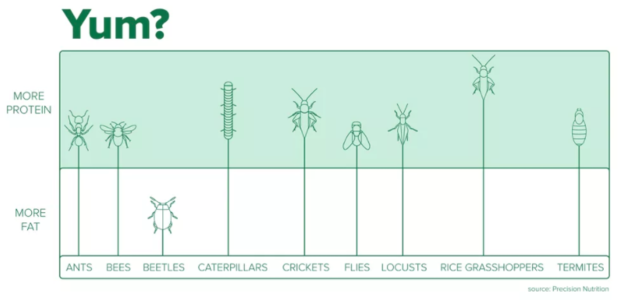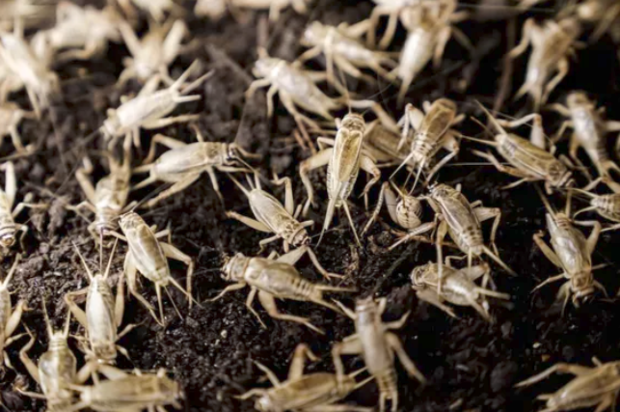You're going to be eating crickets, so just get over it
We all ask our friends for favors. Usually, it's things like rides to the airport or help moving someplace new. I asked my friends to come to my place and eat crickets with me.
"I told everyone at work today I'm eating crickets tonight," my friend Hannah says to me, while I dole out critters into small plastic cups, one flavored cricket per cup.
Some nights you just know are going to be weird.
When my friends Amelia and Adam arrive, we all sit around my dining room table to eat bugs, with two vital ground rules: No Jiminy Cricket jokes. And don't look the crickets in the eyes.
At first, silence -- occasionally punctuated by the barely audible crunch of bugs meeting teeth. But quickly, we're erupting in nervous laughter. The taste test moves on from single crickets to bugs straight from the pouch, a few at a time. The whole-roasted crickets -- which come in flavors like Totally Taco, spicy hot, sea salt and vinegar -- are small, brown and give off a vaguely malty smell and taste that seeps through every seasoning. We crunch, chew, swallow and feel around our teeth for bug parts that get left behind.
I try not to spend too much time looking into the pouches. It's a massacre in there.
All of us eat more crickets than I expect, reaching into the pouches for another helping and getting cricket dust all over our fingers. We establish that the bigger the cricket, the bigger the crunch, and that perhaps you've got to eat a few crickets at a time to really get a sense of the flavor.
Adam thinks the crickets disintegrate too quickly. Amelia finds the texture too ashy. Hannah's winning tasting note reads: "Wings!"
The big question: Would they do it again?
"I don't think I'm ever going to do Netflix and crickets," Amelia says.
Adam thinks he could opt for the protein boost during a workout -- these crickets have about 11 grams of protein in a 28-gram bag, compared with about 7 grams from 28 grams of ground beef. Hannah says they could work in a trail mix.
As an alternative to (or maybe a reprieve from) whole-roasted crickets, I bust out maple cashew granola and chocolate chip cookies made with cricket powder. All of us like the fact we can't taste much cricket at all.
I'll eat anything with taco seasoning on it. Even so, I'm a little surprised to return to the Totally Taco pouch and absentmindedly pull out another cricket as if it's a potato chip.
But as serious as the discussion sometimes gets over flavors we'd like to try and whether every cricket wore the same amount of seasoning as its dead compatriot, none of us could get away from the realization that we'd just eaten bugs.
"If we all wake up tomorrow and have super powers -- or wings...," Hannah says, her voice trailing off. "I can't go to my cousin's wedding with wings, guys."
Eating insects is nothing new. If anything, I was re-introducing my friends to something humans have been doing for millennia. Pliny the Elder wrote that Roman aristocrats loved to eat beetle larvae reared on flour and wine. Aristotle wrote that cicada larvae taste best "before the husk is broken. At first the males are better to eat," but females improve when they're "full of white eggs." You can even find bug-eating references in Leviticus.
Today, cultures across Africa, Asia and Latin American embrace creepy crawly cuisine. In fact, the United Nations estimates at least 2 billion people include bugs in their diets, and there are about 1,900 species including beetles, palm weevil larvae, locusts, ants and grasshoppers just waiting to end up on your plate.
If anything, we're the weirdos.
We might have to get used to the idea. The UN expects the global population to grow by 2 billion people in the next 30 years, reaching 9.8 billion by 2050 -- likely doubling the world's demand for meat. That's where munching a bunch of beetles, crickets, grasshoppers, mealworms and other bugs comes in. Insects grow faster and require fewer resources than livestock do, while emitting fewer greenhouse gasses.
And yes, there are health benefits. While every bug offers something different nutritionally, studies show crickets and mealworms can compete with or even outdo meats like beef and chicken in certain respects, depending on species and what they're fed. The average insect is around half protein by dry weight, according to Precision Nutrition.
That ratio could become even more lopsided, says Jeffrey Swada, director of food science at Michigan State University. That's because crickets are efficient about using what they eat, and there's research being done on what you can feed crickets to make them even more nutrient-rich.
This is mostly old news for the pro-bug crowd.
"One of the main reasons to eat bugs is that there isn't any reason not to," says Daniella Martin, author of "Edible: An Adventure into the World of Eating Insects and the Last Great Hope to Save the Planet." "We are constantly looking for more sustainable options and we are constantly looking to diversify the sources of our nutrition. If that is our ultimate goal, there's no reason not to include insects."
Also, she likes the taste.
Bugs in the system
The first time Mohammed Ashour ate a cricket, he was on live TV.
Ashour and a team of fellow McGill University classmates were in the running for the Hult Prize, a global competition for university students focusing on generating ideas for social good. And they were working on a business plan to address that year's theme of food insecurity (or in plain English, unreliable access to nutritious food).
They wanted to create a sustainable protein source. Put more simply, they wanted to farm crickets for US consumption and fattier palm weevil larvae (also called coconut grubs) for people in Ghana.
During the competition, a local TV station invited Ashour to its morning show and asked him to bring along some crickets to eat. The reporter looked at him and asked, "Will you try one with me?" It was a moment of truth.
"I wasn't ready for that. I needed my own ritual. I needed to spend some time to think and meditate and get myself over things," Ashour tells me.
But it was live TV, so he grabbed a cricket mounted on a wedge of white chocolate and bit down, knowing that no matter what, he had to look like he enjoyed it.
To his surprise, he did -- even without the chocolate.
Ashour's team won the Hult Prize and its $1 million purse with their vision of using data, robotics and automation to build a cricket farm. They're now the Aspire Food Group, based in Austin, Texas. But don't expect to find bucolic fields and non-hipster flannel at Aspire's farm. It's actually a 25,000-square-foot building designed for cricket-raising, in a business park that's about a 10-minute drive from downtown.
"Looking from the outside, you'd never imagine this was a cricket farm," says Ashour. With high ceilings, polished concrete floors and a viewing area behind glass that looks into the farm itself, this isn't Old MacDonald's turf. It looks more like a regular office building with bins stacked on vertical racks.
Each bin can hold about 10,000 to 15,000 crickets at a time. Since crickets take about a month to become big enough to harvest, Aspire produces roughly 22 million every month.
Those crickets will then get cleaned, slow roasted (sans legs and antennae) and either ground up into powder or seasoned and packaged under the brand name Aketta, ready for consumption.
After moving to Austin in 2014, Ashour and his teammates spent a year or so learning everything they could about the biology of raising crickets. In 2016, they developed a process to cheaply and efficiently raise them, cutting down on manual labor. Humans originally fed the crickets, for example -- dumping extra feed into the bins at the end of the day to get them through the night. Now, automated robots on wheels handle chowtime.
Aspire also uses sensors to collect more than 30 million data points relating to habitat, like temperature and humidity.
"That's where a lot of data science and a lot of deep learning and machine learning stuff starts to happen," Ashour tells me.
Chief technology officer Michael Hall says all that data gets fed into an algorithm that figures out optimal factors for things like time and temperature, so Aspire can develop best practices for cricket growing. The big idea is specificity -- like finding the ideal habitat conditions for a cricket at 3 p.m. on day 7 of its life.
"Twenty years ago, if you were trying to measure the temperature and humidity a thousand places in a room, someone would look at you like you're crazy," Hall says of Aspire's sensor-happy setup.
It's a lot of uncharted territory, despite the fact that cricket farming and cricket snacks are starting to jump in popularity (sorry). There's even an organization of cricket industry "stakeholders," called the North American Coalition for Insect Agriculture. Yet as Ashour points out, there's not a lot of institutional knowledge about automated cricket farming to fall back on. Much of the technology Aspire uses is proprietary, and it even uses 3D printing to make parts it can't find in stores.
Fried mealworms. Tasty!
Believe it or not, there are trendier places to eat crickets than my apartment.
The Odd Duck restaurant in Austin -- which is near a spa, at least two yoga studios and a juice bar -- regularly serves Aspire's Aketta crickets. Chef Mark Buley describes it as a small-plates restaurant -- think Spanish tapas-style portions colliding with American food and a light infestation of crickets on the dinner menu. Yelp gives it four and a half stars and three dollar signs.
"[Crickets are] totally an inoffensive texture. It's light and crispy versus that crunchy gooey that everyone was expecting," Buley says, telling me how Odd Duck often fries its crickets and tosses them with an in-house blend of spices called Nacho Spice.
So far, no one's run out the door after getting served chilled melon, smoked green tomato, red onion and cricket togarashi (a peppery Japanese condiment).
But Odd Duck isn't such an odd duck for serving bugs.
There's also Don Bugito, a "prehistoric snackeria" in the San Francisco Bay Area that sells pouches of crickets and toasted mealworms cooked in the pre-Columbian tradition. Saison, a French-American restaurant in San Francisco, gets science-y about its crickets. At Saison's requests, Aspire will feed a batch of crickets lemongrass so the critters assume their own lemongrass flavor. Poquitos in Seattle offers chapulines: toasted grasshoppers with chile-lime salt seasoning. And $4 will buy you a 4-ounce cup of toasted grasshoppers at Seattle Mariners' Safeco Field.
All of this speaks to the idea that bugs aren't just good for you or the planet. They're actually tasty.
"We've fallen victim to this really popular idea that eating crickets is all about hiding the flavor," says Andrew Zimmern, host of the Travel Channel's "Bizarre Foods," who just really appreciates a nice, wok-tossed bumble bee.
Zimmern tells me about the joys of sauteed, buttered beetles and coconut grubs marinated in sour orange juice -- but says he isn't surprised that most of us think bugs are gross. We haven't eaten them prepared with any care or skill.
"A freeze-dried, 2-year-old cricket, seasoned with cheese dust, sold in a novelty pack at a tchotchke store is not going to get anyone excited about eating crickets," he says.
Get over it
Ashour says he realizes he can't win customers by beating them over the head with a moral argument. But Aspire is hoping folks will eventually be able to draw a distinction between the bug on their wall and the bug in their lunchbox -- and that using a name like Aketta could provide the type of disassociation people get from the word "pork" instead of pig.
It's hard to understate how important that is. On the drive home from shooting a video for this story, where I'd crammed a giant handful of crickets into my mouth like popcorn, I couldn't stop thinking about all those black-eyed dead bugs around my teeth -- or the sensation of wiping cricket dust off my chin.
It broke me a little.
But my friend Hannah had a different take. Now that she's tried crickets, she's pretty sure she'd buy them if she saw them in a store.
"I'm really glad, intellectually, that I ate crickets," she told me. "I can now tell people I've eaten crickets and they were taco-flavored, and I would do it again."
Bug appetite.
This article originally appeared on CNET.







